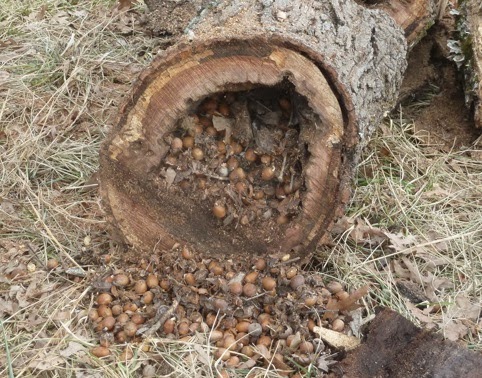 |
| Skunk on the prowl- MDC |
February was the month of "love" for humans and skunks. While we were celebrating Valentine's Day with candy, flowers and expensive restaurants, skunks were risking their lives to find the ladies. We saw six dead skunks just on a drive to Galena last Friday.
March marks the beginning of the mating season for turkeys. Theirs is a safer courtship as they apparently look both ways before crossing the highway and hunting season doesn't start until April. Their courtship is a passionate one, as described by our own Tana Pulles.
"Wild turkey courtship is in full swing during the month of March and will continue through early May. The males begin the courtship season by chasing the females mid to late February. When in sight of a female, tom turkeys, with quivering wings, strut pompously, emitting a series of explosive puffs from their lungs attempting to woo the hens. Rivalry among males may result in bloodshed and even loss of life as stronger toms strike the heads of weaker rivals. The female turkey shows acceptance of the male by strutting near him, then suddenly spreading her wings and throwing herself on the ground before him. This is followed by dramatic mating dances."
 |
| Harbinger of spring- Click to enlarge |
 |
| Wood Duck- Wikimedia |
Blue birds have started arriving, starting their mating cycle. Once again, we have had a few that decided to spend the winter, watching us from the walnut field as we cruised across the pasture. It certainly wasn't because of a mild winter. Maybe they had heard of global warming and decided to take their chances. Either way, this is the time to be sure that your boxes are cleaned out from last year's nestings. If the bluebirds get an early start they might have three broods in a season, although our latest return of the "polar vortex" doesn't bode well.
March should bring out the spring peeper chorus, desperately seeking mates. They have survived the winter with their natural anitfreeze and must be singing to shake off the chill as well as finding mates. We haven't heard them yet, but when it occurs, we can usually hear them as we drive Highway W even with the windows closed. For all that noise, they are really hard to find, like the one below.
 |
| Spring peeper- Click to enlarge - REK |
More to look for:
- Woodcocks begin arriving the last few days in February on their migration North.
- Cardinals begin celebrating Spring Break with their mocking call "teacher-teacher".
- Tree buds begin to wake up. Look for tiny orange cedar berries on female trees, later to turn into blue cones.
- Big Vs of geese are heading north, hard to find at their high altitudes.
- Gobblers begin warming up for mating season.
- Black vultures return to the Ozarks from the south, joining their northern turkey vulture cousins in their recycling duties.
- Mourning cloak butterflies emerge from their bark crevices along with anglewings and goatweeds, species that overwinter as adults.




























